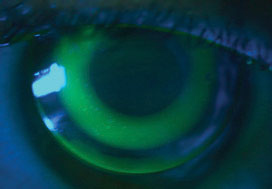 |
| Practitioners considering ortho-K interventions for myopia control should opt to begin sooner rather than later, study finds. Photo: Julie Tyler, OD, and Heidi Wagner, OD, MPH. Click image to enlarge. |
Choosing the optimal intervention for myopia management is increasingly on practitioners’ minds. Orthokeratology (ortho-K) lenses are a popular treatment option, but there have been conflicting reports on various factors, especially the initial spherical equivalent refractive error. In a new study, researchers assessed the efficacy of ortho-K in controlling the rate of myopia progression in children and investigated the factors associated with axial length (AL) growth rate with an average of 48 months of ortho-K lens wear. They found that older age and longer diameter of ortho-k lens contribute to lower AL growth rate.
After initial lens wear, axial length was measured on 84 individuals every 12 months. The researchers compared the differences in growth rates at each time interval. The contribution of the independent variables to AL change was assessed using multiple linear regression.
Age was correlated with the growth rate of axial length and younger myopic children demonstrated a greater growth rate than older ones, which is consistent with the literature.
“Previous studies have generally believed that the effect of age is mainly because of the natural process and development of myopia, which means the AL of younger children grows faster, and the progress of myopia in children gradually slows down with the increase of age,” the authors explained in the study. “For older children with late-onset myopia, they may have experienced a natural decline in the growth rate of AL.”
Given the findings here and elsewhere that ortho-K lenses are more beneficial for myopia control in younger patients, the authors concluded, “for children with early onset myopia, early use of ortho-K lenses can make them obtain the most benefits and delay the progress of myopia so as to reduce the prevalence of high myopia.”
Additionally, a significantly negative correlation was found between diameter of lens and growth rate of AL. In a previous study on the impact of pupil diameter on AL growth in orthokeratology, there were consistent results that children with larger pupils showed significantly less myopia progression during the 24 months visit.
“This could be explained by the fact that the larger pupil allows more light to pass through and fall on the peripheral retina, which induces more myopic displacement in the peripheral retina,” the authors explained in the study.
Lv H, Liu Z, Li J, et al. Long-term efficacy of orthokeratology to control myopia progression. Eye Cont Lens. June 13, 2023. [Epub ahead of print.] |

